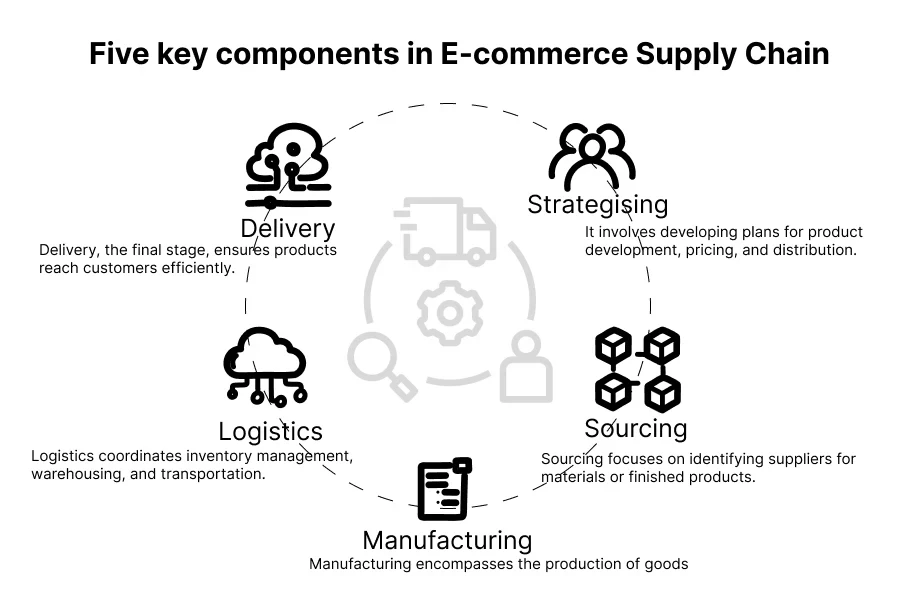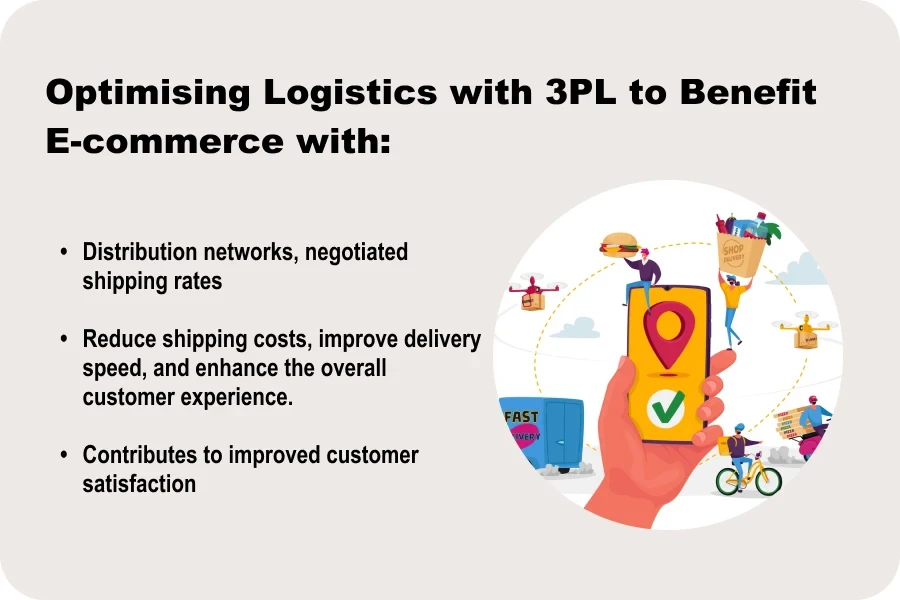Introduction:
In the fast-paced world of e-commerce, building a successful business requires more than just a great product and a user-friendly website. To truly thrive in this competitive landscape, online retailers must develop a robust and adaptable supply chain strategy that can keep pace with the ever-evolving demands of digital consumers. A well-optimized supply chain forms the backbone of any successful e-commerce operation, ensuring that products are developed, sourced, manufactured, and delivered to customers in a timely and cost-effective manner. By streamlining processes, leveraging cutting-edge technologies, and fostering strong partnerships with suppliers and logistics providers, e-commerce businesses can create a seamless experience for their customers while positioning themselves for long-term growth and profitability.
Understanding the E-commerce Supply Chain
The e-commerce supply chain is a complex system that brings products from concept to consumer, consisting of five key components:

The rise of online shopping has significantly impacted e-commerce supply chain management, introducing challenges like increased demand volatility and heightened customer expectations for fast and free shipping. To thrive in this dynamic environment, e-commerce companies must prioritize agility in their supply chain strategies and consider these 5 factors. This involves investing in advanced forecasting tools, diversifying supplier networks, and implementing flexible inventory management practices. A resilient and responsive supply chain is essential for success in the competitive landscape of online retail, ultimately driving customer satisfaction and business success.
Strategies to Enhance E-commerce Supply Chain
There are 5 Strategies provided here to enhance the E-commerce Supply Chain:

This blog is going to break into it one by one:
Optimising Logistics with 3PL for Faster Delivery and Lower Costs
In the age of Amazon Prime, e-commerce businesses face immense pressure to offer fast and affordable shipping options to remain competitive. Customers have grown accustomed to same-day and next-day delivery, raising the bar for online retailers of all sizes. To meet these expectations while keeping costs in check, partnering with third-party logistics (3PL) providers can be an effective strategy:

Third-party logistics (3PL) providers offer significant advantages for e-commerce businesses by providing access to extensive distribution networks, negotiated shipping rates, and specialized expertise. By leveraging 3PLs, businesses can optimize logistics operations, reduce shipping costs, improve delivery speed, and enhance the overall customer experience. Additionally, 3PLs can improve supply chain efficiency, offer better storage options, reduce lead times, and enable businesses to focus on their core competencies. Outsourcing logistics to 3PLs also contributes to improved customer satisfaction, streamlined returns processing, and value-added services like order fulfillment and inventory management. By utilizing the capabilities of 3PL providers, e-commerce businesses can reduce costs, deliver superior customer experiences, and drive growth and success in the competitive online retail market.
Reevaluating Sourcing and Manufacturing Partnerships
As e-commerce businesses grow and evolve, it’s crucial to periodically reassess sourcing and manufacturing partnerships to ensure they align with the company’s goals and priorities. The choice of suppliers and manufacturers can significantly impact product quality, cost, and lead times, which are critical factors in the success of an online retail operation.

When evaluating potential partners, businesses must carefully consider their specific needs and priorities, such as quality, cost, or speed to market, and strike the right balance among these factors. By conducting regular audits of supply chain partnerships and fostering open communication and collaboration with partners, e-commerce businesses can make informed decisions and build a network of trusted suppliers and manufacturers that support their long-term growth and success.
Maximising Warehouse Capacity
As e-commerce sales continue to grow, competition for warehousing space will intensify. Maximizing warehouse capacity is essential for preventing storage limitations.

Implementing strategies such as seasonal storage, increasing space efficiency through extended storage racks and reduced aisle widths, and adopting a warehouse management system (WMS) can help optimize space utilization. A WMS can suggest efficient routes for picking and storing products, provide automated pick lists, and reduce errors, ultimately improving the overall efficiency of warehouse operations.
Focusing on Client-First Customer Support
Customer support is an integral part of the e-commerce supply chain, as the sales process is not complete until the customer successfully receives their product. Providing excellent customer service can lead to increased customer loyalty and willingness to spend more.

Establishing a client-first support system involves considering customer feedback, which can offer valuable insights into various aspects of the supply chain. Collecting and analyzing data from surveys, interviews, and complaint reports can help identify areas for improvement and enhance overall brand performance.
Implementing New Technologies and AI
Staying up-to-date with new technologies is crucial for e-commerce businesses to remain competitive. While larger brands may adopt automation through chatbots and AI, smaller businesses can benefit from cost-effective solutions such as inventory scanner systems and barcode scanning technologies. Cloud-based warehouse management systems (WMS) offer transparency and ensure efficient movement of products through the supply chain. One strategy suggested is automating simple business processes for e-commerce brands to stay competitive.

Adopting procure-to-pay systems and artificial intelligence (AI) supplements can help transfer manual tasks from humans to machines, freeing up employees to focus on more important aspects such as customer service and returns. Automated invoice generation and expenditure analysis reports using AI can streamline operations and provide valuable insights into the supply chain. By identifying weak links and areas for improvement, businesses can make data-driven decisions to optimize their processes.
Conclusion
In today’s competitive e-commerce landscape, optimizing the supply chain is essential for business success. By implementing strategies such as partnering with 3PLs, rethinking sourcing and manufacturing partnerships, automating paperwork and inventory management, maximizing warehouse capacity, adopting new technologies, and prioritizing customer support, e-commerce businesses can streamline their operations, reduce costs, and improve customer satisfaction. Embracing a proactive and agile approach to supply chain management will enable businesses to navigate the challenges of online retail and seize opportunities for growth and competitive advantage. As the industry continues to evolve, e-commerce businesses that prioritize supply chain optimization will be well-positioned to thrive in the years to come.




